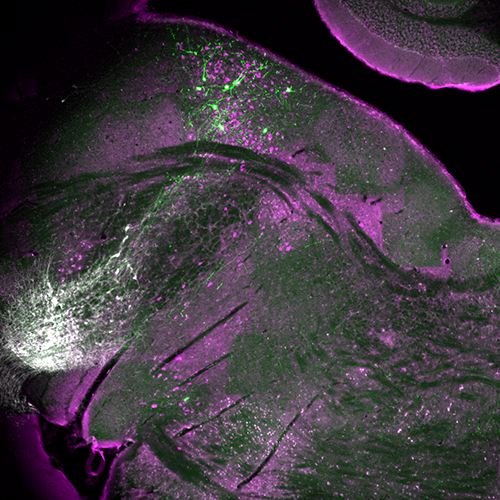By Krissy Lyon
Does serotonin or dopamine make you happy? What is the relationship between these neurotransmitters and the neurons that produce them? If you Google serotonin and dopamine, these are some of the most commonly asked questions.
While serotonin and dopamine are both implicated in mood regulation, how the two interact to modulate behavior is still a largely unanswered question. In our study, we asked, what happens to mouse behavior if we prevent serotonin neurons from receiving dopaminergic signals?

Drd2-Pet1 neurons shown in green in the dorsal raphe of the mouse brain. Serotonin and dopamine shown in purple and white, respectively.
In rodents, most dopamine-producing neurons express receptors for serotonin, affording serotonergic neurons influence over dopamine-regulated reward processing and motor control. By contrast, only a small subset of brain serotonergic neurons express dopamine receptors. These are the Drd2-Pet1 neurons, named for their unique expression of the Drd2 gene encoding the inhibitory D2 dopamine receptor and the Pet1 gene, which is specific to serotoninergic neurons and required for their cell fate. To understand how Drd2 expression in serotonergic neurons affects behavior, we selectively deleted Drd2 in all serotoninergic neurons—generating Drd2 conditional knockout mice (Drd2Pet1-CKO)—and then looked at the behavioral effect.
In these Drd2Pet1-CKO mice, we examined a range of behaviors that serotonin and dopamine are known to be involved in and found that Drd2 expression in serotoninergic neurons is required for sex-specific defensive behaviors, including auditory startle processing in females and social dominance interactions in males. Locomotion, cognition, hearing physiology, and anxiety- and depression-like behaviors were indistinguishable between Drd2Pet-CKO mice and controls, regardless of sex.
Examining also the molecular, cellular, and circuit-level features of Drd2-Pet1 neurons in males versus females, we found sex-specific differences in the proportional distribution of axonal collaterals, in action potential duration, and in transcript levels of Gad2, important for synthesis of the inhibitory neurotransmitter GABA. Our results suggest that DRD2 function in Drd2-Pet1 neurons is required for normal defensive/protective behaviors in a sex-specific manner, and that this may be influenced by the identified sex-specific molecular and cellular features of these neurons. Related behaviors in humans too show sex differences, suggesting translational relevance, for example to disorders like autism, post-traumatic stress, substance abuse withdrawal, and schizophrenia.
Krissy Lyon is a recent graduate of the Program in Neuroscience, working in the lab of Susan Dymecki in the Department of Genetics at Harvard Medical School.
This story will also appear in the HMS Neurobiology Department newsletter, The Action Potential.
Learn more in the original research article:
Sex-specific role for dopamine receptor D2 in dorsal raphe serotonergic neuron modulation of defensive acoustic startle and dominance behavior. Lyon KA, Rood BD, Wu L, Senft RA, Goodrich LV, Dymecki SM. eNeuro. 2020 Nov 19:ENEURO.0202-20.2020. doi: 10.1523/ENEURO.0202-20.2020.
Learn more about Krissy in her Humans of HBI profile here.
News Types: Community Stories
